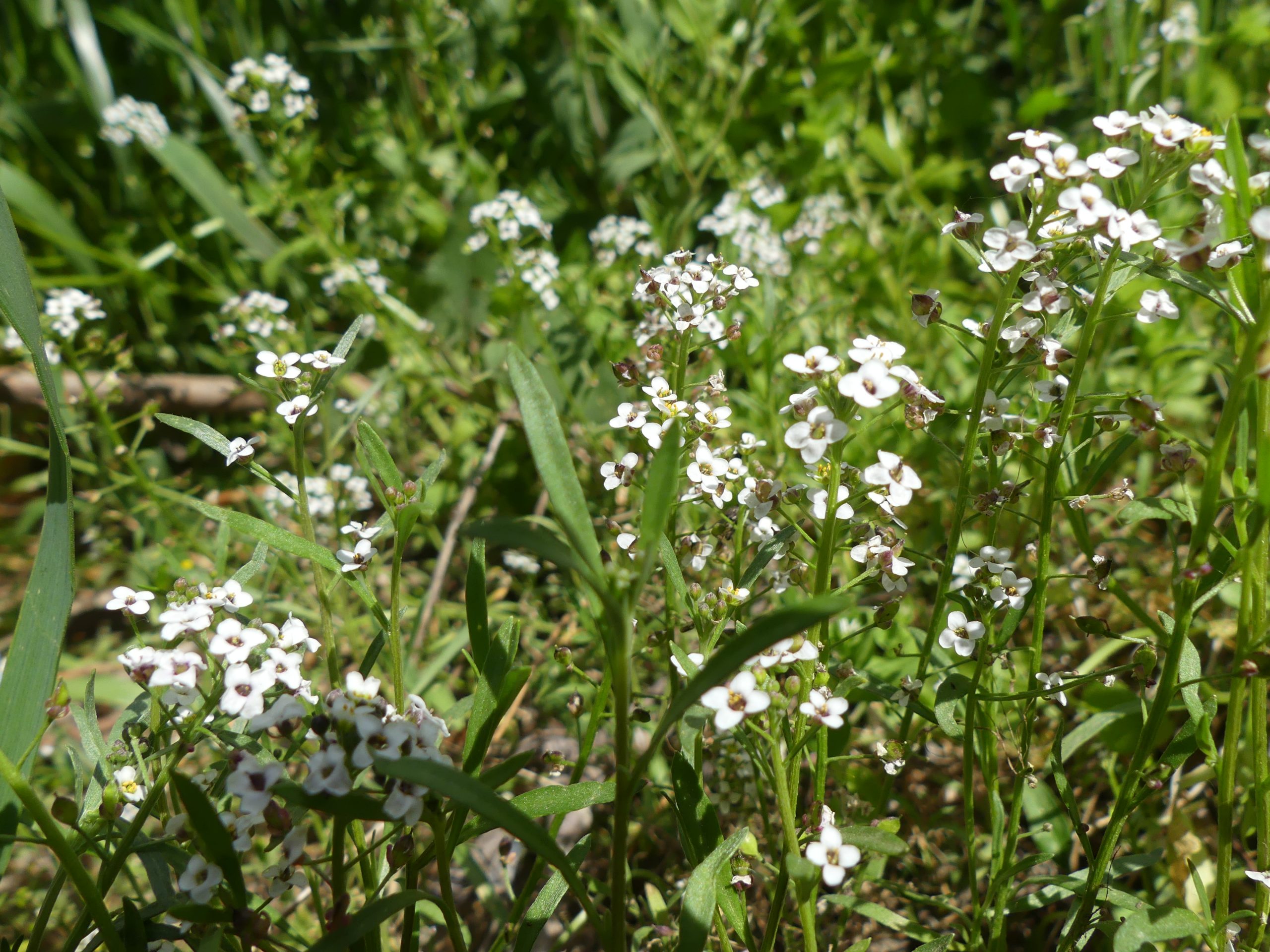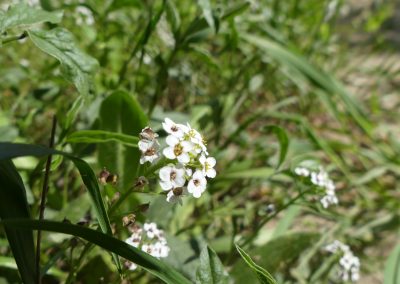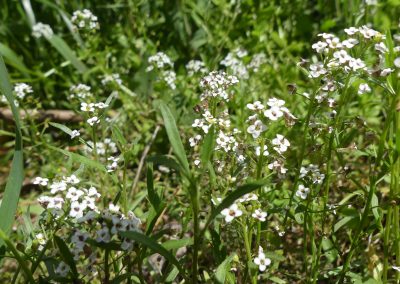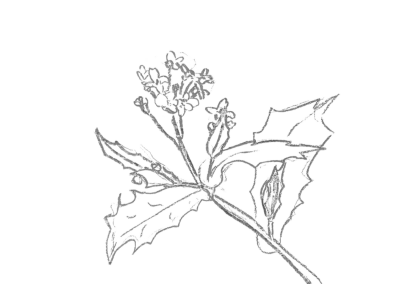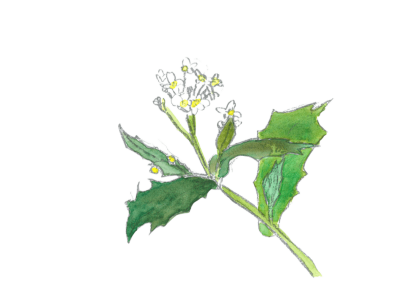Calepina irregularis
Scientific description
Taxon: Calepina irregularis
Class: Magnoliopsida (Dicotyledons)
Subclass: Rosidae
Order: Brassicales
Family: Brassicaceae
Common name: Irregular calepine
Origin:
Europe, Western Asia, North Africa.
Description:
Calepina irregularis is an annual plant growing 30 to 80 cm tall with a spreading habit and ascending stems. Basal leaves form a rosette, while upper leaves are oblong, entire or sometimes toothed, and clasp the stem.
Flowering occurs from April to July, with small white flowers arranged in narrow elongated clusters. It is a common plant found in cultivated fields and wastelands across Central and Southern Europe, Western Asia, and Algeria.
Propagation:
Mainly reproduces by seeds naturally dispersed.
Ecology:
Occurs in open, often disturbed habitats such as cultivated fields, fallow land, and roadside edges. Prefers light, well-drained soils and temperate to Mediterranean climates.
Use:
No known significant uses. It is a common wild plant without recognized food or medicinal value.
Taxon : Calepina irregularis
Classe : Magnoliopsidées (Dicotylédones)
Sous-classe : Rosidées
Ordre : Brassicales
Famille : Brassicacées
Nom commun : Calépine irrégulière
Origine :
Europe, Asie occidentale, Afrique du Nord.
Description :
Calepina irregularis est une plante annuelle de 30 à 80 cm de hauteur, au port étalé avec des tiges ascendantes. Les feuilles basales forment une rosette, tandis que les feuilles supérieures sont oblongues, entières ou parfois dentées et embrassantes.
La floraison a lieu d’avril à juillet avec de petites fleurs blanches regroupées en grappes étroites et allongées. Plante commune, elle pousse dans les cultures et friches d’Europe centrale et méridionale, d’Asie occidentale et d’Algérie.
Multiplication :
Se reproduit principalement par graines, dispersées naturellement.
Écologie :
Habite les milieux ouverts, souvent perturbés comme les champs cultivés, friches, bords de chemins. Préfère les sols légers, bien drainés, et un climat tempéré à méditerranéen.
Utilisation :
Pas d’utilisation notable à ce jour. Principalement une plante sauvage commune sans usage alimentaire ou médicinal reconnu.
Taxon: Calepina irregularis
Clasă: Magnoliopsida (Dikotiledonate)
Subclasă: Rosidae
Ordin: Brassicales
Familie: Brassicaceae
Denumire populară: Păducel
Origine:
Europa, Asia de Vest, Africa de Nord.
Descriere:
Calepina irregularis este o plantă anuală de 30-80 cm înălțime, cu tulpini ascendente și habitus răspândit. Frunzele bazale formează o rozetă, iar cele superioare sunt oblongi, întregi sau uneori dințate, înconjurând tulpina.
Înflorește din aprilie până în iulie cu flori mici albe, grupate în ciorchini înguști și lungi. Este o plantă comună, care crește în terenuri cultivate și terenuri necultivate din Europa Centrală și de Sud, Asia de Vest și Algeria.
Multiplicare:
Se înmulțește în principal prin semințe, dispersate natural.
Ecologie:
Trăiește în habitate deschise, adesea perturbate, precum terenuri cultivate, terenuri necultivate și margini de drumuri. Preferă soluri ușoare, bine drenate și climat temperat spre mediteranean.
Utilizare:
Fără utilizări cunoscute. Este o plantă sălbatică comună fără utilizare alimentară sau medicinală.
Ταξινόμηση: Calepina irregularis
Κλάση: Magnoliopsida (Δικοτυλήδονα)
Υποκλάση: Rosidae
Τάξη: Brassicales
Οικογένεια: Brassicaceae
Κοινό όνομα: Ακανόνιστη Κάλεπινα
Προέλευση:
Ευρώπη, Δυτική Ασία, Βόρεια Αφρική.
Περιγραφή:
Η Calepina irregularis είναι ετήσιο φυτό ύψους 30 έως 80 εκ., με διακλαδισμένο ύφος και ανυψωμένους βλαστούς. Τα κατώτερα φύλλα σχηματίζουν ροζέτα, ενώ τα ανώτερα είναι λογχοειδή, ακέραια ή μερικές φορές οδοντωτά και περιβάλλουν τον βλαστό.
Η ανθοφορία γίνεται από Απρίλιο έως Ιούλιο, με μικρά λευκά άνθη σε μακριά και στενά στάχια. Είναι κοινό φυτό σε καλλιεργημένες εκτάσεις και ακαλλιέργητα χωράφια στην Κεντρική και Νότια Ευρώπη, τη Δυτική Ασία και την Αλγερία.
Πολλαπλασιασμός:
Αναπαράγεται κυρίως με σπόρους, που διασπείρονται φυσικά.
Οικολογία:
Ευδοκιμεί σε ανοιχτά, συχνά διαταραγμένα ενδιαιτήματα όπως καλλιεργούμενα χωράφια, αγραναπαύσεις και άκρες δρόμων. Προτιμά ελαφρά, καλά στραγγιζόμενα εδάφη και εύκρατο έως μεσογειακό κλίμα.
Χρήση:
Δεν έχει γνωστή χρησιμότητα. Είναι κοινό άγριο φυτό χωρίς διατροφική ή φαρμακευτική χρήση.
Creative writing inspired by Calepina irregularis
Irregular Hawthorn
In a quiet corner of the forest, there was a little plant called the Irregular Hawthorn. Unlike the other plants, its leaves were all different: some were long, some round, some smooth and some jagged - the other plants often laughed at it.
“Look at those leaves! they're so messy!” said the oaks and ferns. “You'll never be as elegant as we are.” Hawthorn felt sad, but deep down she knew there was something special about her.
One hot afternoon, a bolt of lightning struck the forest, starting a fire. Plants and animals panicked, running in all directions to escape. Smoke filled the air and all hope seemed lost. But then a surprising thing happened: the irregular Hawthorn began to give off a sweet, fresh scent. The animals smelled it and followed the aroma, which led them to a nearby river, far from the fire.
Thanks to Hawthorn, many lives were saved. When the fire was finally extinguished, the plants that had mocked Hawthorn now looked at her with admiration. “Thanks to you, the forest is alive,” said an old oak. Irregular Hawthorn no longer felt sad. She had learned that difference was not a flaw, but her greatest strength.
From that day on, Hawthorn continued to grow in the heart of the forest, reminding everyone that being unique can save the day.


